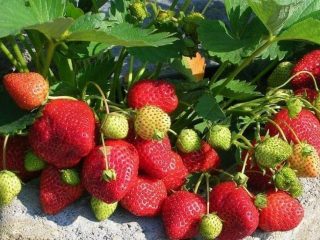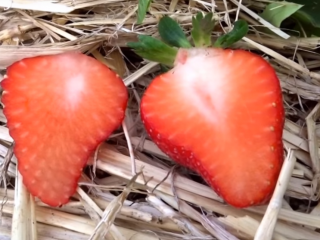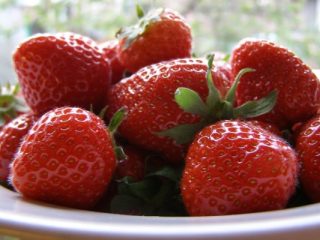Content
Malga strawberry is an Italian variety, bred in 2018. Differs in long-term fruiting, which lasts from the end of May until the first autumn frosts. The berries are large, sweet, with a strawberry aroma. The yield, even with normal care, is more than one kilogram per plant.
Breeding history
Malga is a variety of Russian origin, bred in Verona (Italy) in 2018. The author is a private breeder Franco Zenti. The work was carried out on the basis of the agricultural company Geoplant Vivai Srl. The variety is not included in the Russian register of breeding achievements. The plant is very hardy, so it can be cultivated in most regions of Russia (outdoors, under a film cover, as well as on a balcony or loggia).
Description and characteristics of the Malga strawberry variety
Bushes of a plant of medium height, moderately spreading, take up little space. The leaves are small in size, dark green in color, the surface is leathery, with mild wrinkles. The foliage of the bush is medium - light freely gets to different parts of the plant. Malga strawberry produces many flower stalks that rise well above the green part. A little mustache appears.
Characteristics of fruits, taste
Malga strawberries are large in size, reaching 35–45 g. The shape is classic - conical, red, bright, with an attractive orange tint. The surface is glossy, shines in the sun. After ripening, it does not darken, retains its original appearance.
The pulp is moderately dense, juicy, no voids. The taste is pleasant, with pronounced sweetness and delicate sourness. There is a persistent aroma of wild strawberries. Malga berries are especially tasty when fresh. They are also used in preparations - preserves, jams, fruit drinks.
Ripening terms, yield and keeping quality
Malga strawberry belongs to the remontant varieties. It bears fruit continuously from the end of May until the first frost, which is an absolute advantage over many other varieties. The first berries reach full ripeness within two weeks after flowering. The strawberry Malga has a high yield. Even with standard agricultural techniques, at least 1 kg of berries can be removed from each bush.
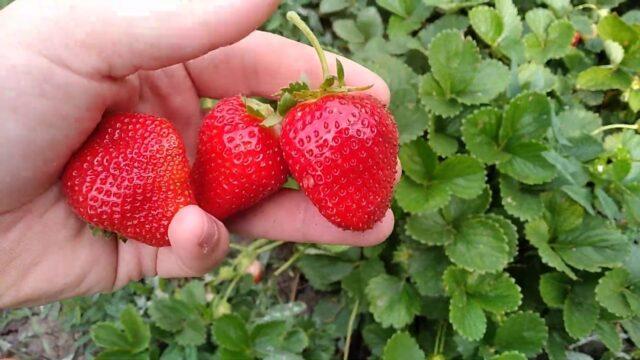
Malga strawberries are high-yielding varieties.
The fruits are dense, so they keep their shape well. They can lie in the refrigerator for several days without losing taste and firmness. They tolerate long-distance transportation well.
Growing regions, frost resistance
Despite the fact that Malga strawberry was bred in Italy, it is suitable for cultivation in most regions of Russia, including the North-West, the Urals, Siberia and the Far East. In cold regions, it is better to cultivate under a film cover or in a greenhouse. The variety is frost-resistant, but the bushes should be covered for the winter. Good resistance to prolonged rains is noted - the roots and stems do not rot, fruiting is normal.
Disease and pest resistance
In the description of the Malga strawberry variety, it is indicated that the bushes are distinguished by good resistance to pests and diseases (verticillary wilting, gray rot).But it is not worthwhile to completely exclude the defeat of diseases. An invasion of pests is also possible - weevils, aphids, leaf beetles and others.
For prophylaxis in April (before the formation of buds), it is recommended to carry out a single treatment of Malga strawberries with any fungicide:
- Bordeaux liquid;
- Horus;
- Fitosporin;
- Teldur;
- Signum.
Folk remedies can effectively deal with insects, for example, infusion of onion peels, garlic cloves, mustard powder, decoction of potato tops. For the prevention of aisles, sprinkle with wood ash, which at the same time serves as a source of minerals.
But in the later stages, these measures are ineffective. You have to use chemical insecticides, for example:
- Inta-Vir;
- "Match";
- Aktara;
- "Decis";
- "Confidor" and others.
Malga strawberry bushes are processed in cloudy weather or in the late evening, preferably in the absence of wind and rain.
Advantages and disadvantages of the variety
Malga strawberry bears fruit all season and produces not only beautiful, but also delicious berries. This variety has already begun to spread in Russia and other countries, as it has some advantages.
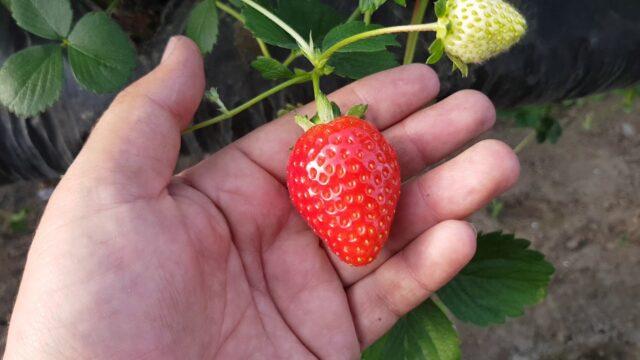
Malga strawberries give delicious presentation berries
Pros:
- fruiting all summer and early autumn;
- the taste is pleasant, the aroma is pronounced;
- high productivity;
- fruits do not bake in the sun;
- waterlogging resistance;
- frost resistance;
- immunity to major diseases;
- whiskers are few, they do not affect the yield.
Minuses:
- if the summer is cloudy, rainy, then acid is noticeable in the taste;
- immunity to anthracnose is weak;
- exactingness to feeding;
- independent propagation of culture is ineffective.
Reproduction methods
Malga strawberries can be diluted with a mustache and dividing the bush. The first method is inconvenient, since few shoots are formed. But on 1-2 bushes, you can remove a significant part of the peduncles, then there will be more mustache. They are carefully picked before fruiting. The bushes are transplanted into fertile, loose soil, next to the mother plant. Water it periodically, making sure that the soil does not dry out. For the winter, mulch with leaves, hay, sawdust.
It is advisable to divide adult three-year-old bushes, since the yield of Malga strawberries, like other varieties, decreases with age. You can start the procedure in May or September. To do this, dig up several bushes, put them in a container with warm water and divide the roots. If necessary, prune tangled shoots with a knife. Planted in fertile soil, watered. In the case of autumn breeding for the winter, they are carefully mulched. This procedure is recommended to be repeated every 3 years.
Planting and leaving
Malga strawberries must be purchased from trusted suppliers. Planting seedlings in pots (roots covered) can be planned from late spring to early fall. When breeding with a mustache, it is better to plant them in July.
The place for cultivating Malga strawberries should be well lit, without shade. Lowlands where moisture accumulates are excluded. The beds are oriented from north to south for more even illumination. The soil should be slightly acidic (pH 5.5 to 6.0), loose and fertile (loam). If the soil is depleted, humus is introduced into it a month before planting. You will need 5 kg per 1 m2. If the earth is clay, then sawdust or sand must be sealed (500 g per 1 m2). For acidification, you can add 200 g of wood ash to the same area.

Malga strawberry bushes can be planted at minimum intervals
When placing, observe the distance:
- 20 cm - between the holes;
- 60 cm - row spacing.
Malga strawberry bushes do not need to be buried, on the contrary, the root collar is watered a little so that the growth point is above the surface. In the first 15 days, daily watering is required.In this case, the soil will be compacted, and the neck may go underground.
To grow beautiful and healthy Malga strawberries, as shown in the photo and in the description of the variety, gardeners in their reviews recommend adhering to the following rules:
- Watering with warm water 2 times a week, in drought - three times.
- During flowering, drip irrigation is used instead of traditional humidification. You can pour water gently without getting on the flowers.
- Fertilizing strawberries Malga regular: in mid-May, urea (15 g per 10 l per 1 m2) and mullein (diluted 10 times) or droppings (20 times). During the formation of peduncles, feeding with a mullein is repeated, and at the end of August, superphosphate is introduced (30 g per 10 l per 1 m2) and potassium sulfate (20 g per 10 l per 1 m2). Wood ash can be added (100 g per 1 m2). Nitrogen at this time is categorically excluded.
- After heavy rains, the soil should be mulched. At the same time, weeding is done.
- It is advisable to mulch Malga strawberries with organic matter (peat, needles, leaves, sawdust). The mulch is changed every month. Instead, you can use the well-proven method of growing on black agrofibre sheet.
Preparing for winter
In all regions where strawberries are planted, Malga must be mulched, as due to temperature changes, the roots can become icy. Because of this, the plant will not recover next spring. In early October, remove all dried leaves. The bushes are covered with agrofibre or sprinkled with a large (10 cm) layer of straw or sawdust.
The sawdust will have time to overheat, but you should not throw them away. The material is placed in a compost heap to obtain organic fertilizer.

The variety is suitable for fresh and canned consumption
Conclusion
Malga strawberries are suitable for growing in private and private farms. This is a new variety that has only recently begun to penetrate into Russia and other countries. Attractive for stable, long-term fruiting, good immunity and resistance to adverse weather conditions. This makes it possible to grow Malga strawberries even in the Urals, Siberia and the Far East.
Gardeners' reviews about Malga strawberries




